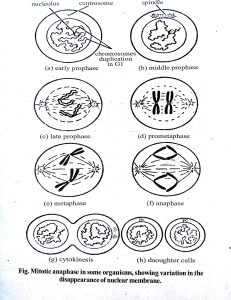Stages of Mitosis
Stages of Mitosis
There are following stages of mitosis-
-
Prophase-
At prophase (after DNA synthesis is already completed during interphase), the cell is still preparing for division. At the beginning of prophase chromosomes appear as thin, filamentous uncoiled structures. Chromosomes become coiled, shortened and more distinct as the mitosis progresses through prophase, which is of much longer duration than other stages.
As an important characteristic of mitotic prophase is longitudinal splitting of each chromosome into sister chromatids. Double structure of each chromosome thus may be conspicuous at late prophase. This feature can be easily observed in suitably fixed plant or animal chromosomes. Sister chromatids at this stage are attached only at centromere and it will be at this position that two chromatids will now remain attached to spindle tubule. Soon after, the nuclear membrane disappears at late prophase.
Similarly, nucleolus also disappears before the cell enters mitotic metaphase. However, there are variations available with respect to the disappearance of nuclear membrane and the nucleolus. In a number of primitive plant and animal species, the nuclear membrane does not dissolve.
-
Metaphase-
At late prophase or early metaphase, spindle tubules start appearing. These tubules get attached to chromosomes at centromeres. The chromosomes begin active movement leading to arrangement of chromosomes in the centre or at equatorial plate. The spindle apparatus, which help in arrangement of chromosomes at the plate, is formed with the help of centrosome particularly in case of animal cells. Centrosome has two centrioles which separate at the time of spindle formation and occupy positions on opposite sides of nucleus. As two centrioles separate, astral rays appear radiating outward from each centriole. These will join and form spindle fibres. In most plants, centrosomes are missing, but spindle apparatus is still formed.
-
Anaphase-

After spindle is formed and chromosomes have arranged on equatorial plate, chromosomes split at centromeres also. Sister centromeres separate from each other, so that the two sister chromatids are separate structures and can now be called chromosomes. These sister chromatids of daughter chromosomes now move towards opposite poles of spindle. The mechanism of movement of chromosomes at anaphase has been explained in different ways by different workers. It seems that there is repulsion between centrosomes and that there is contraction of spindle fibres which helps the movement. At anaphase, chromosomes will attain characteristic shapes depending upon position of centromere. Chromosomes would be V shaped, J shaped and I shaped in metacentric, sub-metacentric and acrocentric chromosomes respectively.
-
Telophase-
After anaphase, chromosomes reach the poles, nuclear membrane is reconstructed around each group of chromosomes giving rise to one nucleus at each pole. The nucleoli also reappear at this stage.
(I) Cytokinesis- Division of one nucleus into two is often called karyokinesis and is followed by cytokinesis, which divides cytoplasm into two cells and can be brought about in two ways.
-
Cell furrow-
In case of animals, outer layers are more flexible due to absence of cell wall. In such cases, a circular constriction appears at the equator and it converges on all sides finally separating two daughter cells.
-
Cell plate-
In plant cells, a more rigid cell plate is usually initiated at centre and is completed towards periphery. After the cell plate is laid down, primary walls are deposited on either side. The thick secondary cell-walls of cellulose may be laid down later on.
(II) Chromosome numbers and mitosis- Metaphase stage of mitosis is often used for determining chromosome numbers in animals as well as in plants. Chromosome numbers of some important animals and plants as determined by mitotic metaphase.
Important links
- Structure of Chromosome | Euchromatin & Heterochromatin
- Molecular Structure of Chromosome (Nucleosome Structure)
- Meristem & Meristematic Tissue- Definition, Characteristics, Types
- Apical Meristem Theories of Root and Shoot apex
- Affinities of Gymnosperms- with Pteridophytes & Angiosperms
- Economic Importance of Gymnosperms
- Placentation in Plants- Definition, Type, Evolutionary Trends
- Essential Oils- Meaning & its Extraction
- Fatty Oils & their Classification (Various Types of Oils)
Disclaimer: wandofknowledge.com is created only for the purpose of education and knowledge. For any queries, disclaimer is requested to kindly contact us. We assure you we will do our best. We do not support piracy. If in any way it violates the law or there is any problem, please mail us on wandofknowledge539@gmail.com
